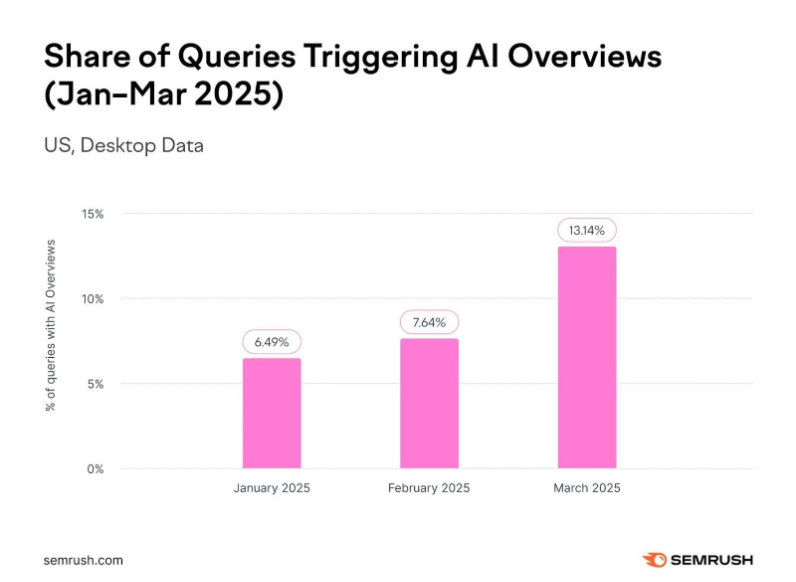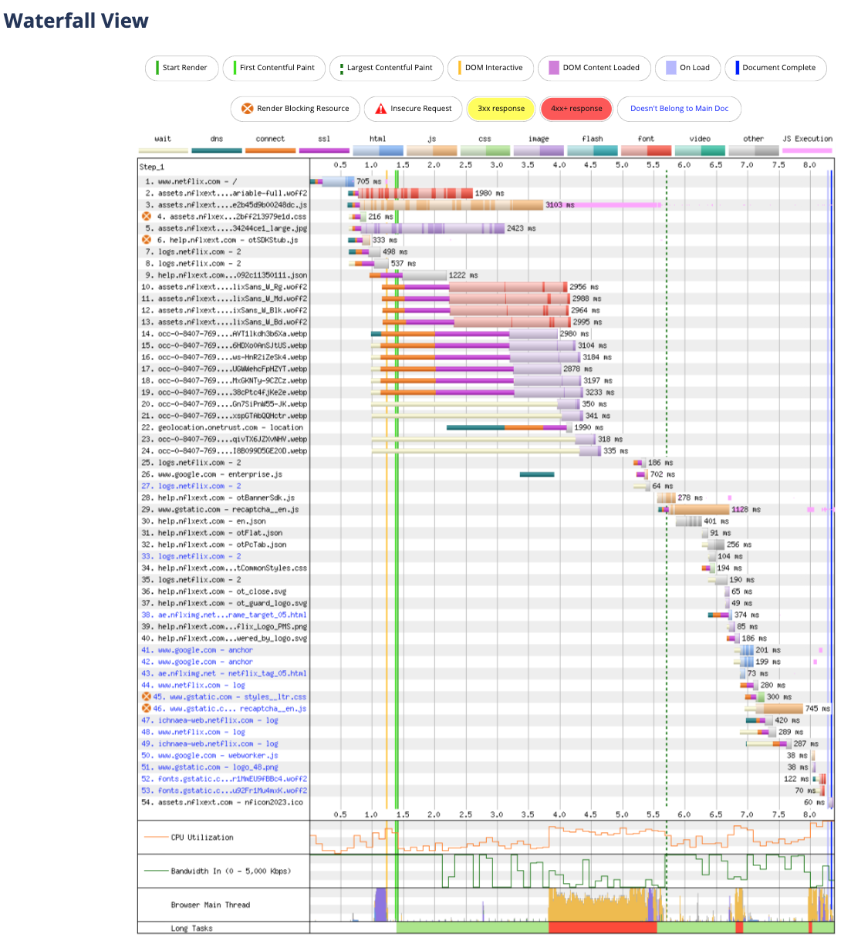From SEO to AEO: Why Web Performance Is the Key to AI Search Success
Search isn’t what it used to be. The way people discover information online is shifting. Instead of clicking through search results, many now ask AI answer engines like ChatGPT and Perplexity to do the research for them.
In March 2025, 13.1% of Google desktop searches featured AI Overviews— doubling from over 6% in January, according to Semrush analysis of 10+ million queries. Meanwhile, Gartner predicts that by 2026, a quarter of all search traffic will shift to AI assistants, with ChatGPT alone already serving 400+ million users each week.

This means getting your content recommended by these AIs – a practice called Answer Engine Optimization (AEO), also called Generative Engine Optimization (GEO) – has quickly become a priority for brands that want to stay visible. You need to be the go-to answer when your audience turns to AI for help.
But a Search Engine Land study of nearly 8,000 AI citations shows just how fragmented the ecosystem is:
- ChatGPT leans heavily on sites like Wikipedia and Reddit
- Perplexity diversifies across news publishers and niche blogs
- Google’s AI Overviews mix in Reddit, Quora, and authoritative domains
The takeaway? AI answer engines are black boxes that change often, and it’s hard to keep up with where and how you’ll get cited. But one thing remains unchanged: web performance still matters.
If your website isn’t fast, stable, and reliable, you’ll reduce your chances of being cited. AI systems pull from multiple sources, and performance is one factor that can determine whether your page is included in those answers.
SEO vs AEO: Shared foundations, new challenges
SEO isn’t going away. The fundamentals (quality content, smart keyword use, structured data, and Core Web Vitals) remain essential.
But AEO raises the bar:
- AI assistants give fewer answers. Instead of ten links, users may see one or two citations. You want to be one of them.
- AI crawlers are selective: Many use lightweight crawling. They don’t reliably execute heavy JavaScript and won’t wait long for slow-loading content.
- Zero-click search is real. In SEO, clicks to your site are the primary measure of success. But with AEO, zero-click answers are common – AI engines might give the user what they need right inside the interface, without anyone visiting your page. That means your brand’s visibility depends on being cited, not just ranked.
Why performance still matters in AI search
When it comes to being seen by AI, performance isn’t a bonus—it’s a baseline. Here’s why it still matters more than ever:
- Speed = visibility. Google already factors speed into SEO rankings. AI answer engines need speed even more to generate responses in real time. A slow site can lose its chance at being considered.
- Stability = trust. Sites that render smoothly and reliably keep users engaged and signal quality to AI systems.
- Global reach = inclusivity. AI searches come from everywhere. If your site only performs well locally, you risk being excluded from global answers.
Catchpoint’s Banking Website Benchmark Report showed that only 1 in 4 banks delivered pages in under 3 seconds despite nearly perfect uptime.

2025 Banking Website Benchmark Report: Top 10 banks by Document Complete
The winners weren’t just online; they were consistently fast everywhere. And it’s not just banking. Our industry benchmark reports show the same trend across retail, SaaS, and travel.
How to optimize your website performance for SEO and AEO
Optimizing web performance is important for both SEO and AI SEO. Here’s a roadmap to improve your website’s performance.
1. Measure and monitor your performance continuously
You can’t improve what you don’t measure. Begin by benchmarking your site’s speed and responsiveness across geographies, devices, and networks using WebPageTest. Run tests to track your performance metrics and test your critical user journeys to identify potential issues.
Combine real-user monitoring data with synthetic tests to get a full picture of your site’s health. This approach lets you see how real visitors experience your pages and also catch issues proactively in a controlled environment. The goal is to have eyes on your website’s performance 24/7, so you can spot and fix small slowdowns before they snowball.
For teams juggling both proactive testing and real-world data, the WebPageTest Expert Plan offers a unified way to combine synthetics with real user monitoring (RUM) for full visibility.
2. Tackle the usual suspects
- Server response (TTFB): Time to First Byte (TTFB) is how long it takes your server to respond after a request is made. If this is slow, everything else will be too. Speed up backend processes, cache aggressively, and use a CDN to reduce latency.
- Heavy assets: Compress images, switch to modern formats (WebP/AVIF), and lazy-load below-the-fold content.
- Render-blocking resources: A quick look at the WebPageTest waterfall chart can reveal exactly which CSS or JavaScript files are slowing down the first paint. It’s a favorite among performance engineers because it shows the loading order of every resource, making it easy to spot what’s blocking rendering. Once identified, defer or async non-critical scripts, and inline critical CSS to help content appear faster.

- Third-party scripts: Audit frequently — ads, analytics, and widgets can slow you down.
- Core Web Vitals: Focus on Largest Contentful Paint (LCP), Cumulative Layout Shift (CLS), and responsiveness (INP). These metrics aren’t just SEO signals — they also make your site more AI-friendly.
3. Don’t forget the backbone
DNS lookups, CDN routing, and TLS handshake times all impact how quickly your site loads. A sluggish DNS could mean you’re left out of the answer entirely. DNS plays a bigger role than most people realize.
To dive deeper, join us on September 24th for our webinar “Beyond SEO: How DNS Impacts AI Search and Web Performance” with Matthew Bowes (Metamend) and Terry Bernstein (IBM NS1 Connect). We’ll explore how DNS and performance together shape your visibility in today’s AI-powered search world.
4. Keep monitoring and improving
Web performance isn’t a one-and-done project. Every new script, image, or design tweak can tip the scales. Continuous monitoring with synthetic + RUM, combined with smart alerting, ensures you catch regressions and fix issues before they affect experience or search ranking.
Wrapping it up
SEO isn’t dead — it’s evolving. AEO means your site must be discoverable and deliver a great experience instantly. High-quality, authoritative content paired with fast, stable, and trustworthy pages gets prioritized by answer engines.
AI search may feel like a black box that changes often. But performance is a constant you can control. By measuring performance from all angles, fixing bottlenecks, and monitoring continuously, you’ll protect both your rankings and your brand’s visibility in AI-driven search.
Learn more
- Want to know what the fastest sites have in common? Check out our recent blog post sharing our learnings from recent industry benchmark reports
- Register for our webinar “Beyond SEO: How DNS Impacts AI Search and Web Performance” with Matthew Bowes (Metamend) and Terry Bernstein (IBM NS1 Connect). [insert link]
- For a deeper look at best practices for keeping your site fast and resilient over time, check out our Web Performance Monitoring Guide.




